Buddhism has developed into one of the major religions of the world with many schools and branches. Buddhist cultural practices vary from country to country. While performing these traditional practices, we should be careful not to classify Buddhism as belonging to any of them.
For example, we should not think in terms of Chinese Buddhism, Japanese Buddhism, Tibetan Buddhism, Thai Buddhism, Sinhalese Buddhism, or Burmese Buddhism.
Today in this article we’ll know about:- How Buddhism practices help us in Finding Inner Peace and How we can Find Inner Peace Buddhism.
Page Contents
How to Find Inner Peace Buddhism
Buddhism focuses on the ability to become enlightened by observing oneself or within oneself, rather than studying any external sources. Also central to Zen Buddhism’s belief is the idea that meditation is one of the dominant practices that promotes enlightenment, as well as inner peace and happiness.

You may all have seen my previous articles talking about what is inner peace, how to find inner peace, and, why is inner peace important.
We also have a lot of Inner Peace Buddhism Tattoos designs, symbols, and ideas for you.
So in this article, I’ll be highlighting the fact that how Buddhism helps us in finding inner peace Buddhism and how can we achieve inner peace.
So let’s start the ways or practices of Finding Inner Peace Buddhism.
Right Understanding for Buddhist symbol for peace
Developing the right understanding involves gaining knowledge and clarity on Buddhist teachings (buddhist symbol for peace).
After understanding the basic beliefs of Buddhism Inner Peace, a person develops a proper understanding of reality, life, suffering, and knowledge .With the right understanding, you can rid yourself of confusion and see the world and your personal life for what they really are.
Right Intentions for Inner Peace Buddhism
Right intentions include an understanding of your motivations and underlying thoughts.
To develop the right intention, you need to be aware of anything in your life that stems from wrong intentions, such as greed, hatred, jealousy, and vengeance . Instead, cultivate with the right intentions and work with a feeling of love and compassion for others.
Right Speech for Inner Peace Buddhism
Right speech involves communicating in a way that protects others from being hurt, whether through slander, gossip, or abusive language.
Right speech (or more commonly, right communication) does not include the remaining silence about your opinion; Instead, you should judge the motives behind every communication.
The insidious speech should also be avoided. Another way to think about it is that you should just say something if it is right, profitable, and timely. If not, you have no need to say it.
Right Action for finding Inner Peace Buddhism
Developing the right action insists on behaving in an ethically acceptable manner, avoiding actions that harm others, and instead try to do good.
You must build self-control and avoid all wrongdoing, such as murder and theft .Instead, be conscious of the rights and feelings of others. You alone are responsible for making decisions about morality and determining whether a particular action is right, stems from honorable intentions, and is unlikely to harm anyone.
Right Effort for Inner Peace Buddhism
Leaving the right effort is actively working to release negative thoughts, words, and actions and is instead all positive and beneficial.
Right effort means that you are directing your energies, and making sure that you are striving in things that will benefit you and others.
Right Livelihood for Inner Peace Buddhism
The right livelihood includes both your type of employment and how to address work and the workplace.
Not only should you avoid any livelihood that harms others, but it is also important that you use correct speech and actions at work, treat your colleagues with respect, develop a good work ethic, And work out of honorable intentions.
However, it is up to you to determine whether your livelihood harms others, is neutral, or helps others.
It has been suggested that the right to livelihood is to avoid dishonesty, immorality, theft, and the inclusion of alcoholic or addictive drugs, and helps in finding inner peace Buddhism .Right Mindfulness for Inner Peace Buddhism
Right mindfulness means that everything you do and avoid speaking without talking is objectionable. If you are paying attention to people’s thoughts and feelings, it will help you to influence how your words and actions affect others.
It is also important to pay attention to your mind and your thoughts; To develop the right mindfulness, pay attention to where your brain is throughout the day. Many people have habits of getting lost in thought, thinking about the past, and future rather than dwelling at the moment in hand.
True mindfulness involves paying full attention to one’s surroundings.
Right Concentration for Inner Peace Buddhism
Right concentration is also called Right Meditation, and you can use the practice of meditation to develop your concentration.
Right concentration involves concentrating solely on one object. By developing the right concentration, you further ground yourself in the present and develop control over your mind .The right concentration achieved through meditation also helps you to calm the mind (Peace of Mind), finding inner peace Buddhism, and enables you to develop deeper wisdom and understanding.
Right Meditation – Zazen Meditation (Inner Peace Buddhism)
Understanding what meditation is and how to practice it is therefore essential to Zen Buddhism.
Meditation is, at its core, a way of developing the mind and focusing its thoughts. Meditation helps you gain Buddhism Peace of mind, control of both your mind and body, and the results of meditation will spread to all parts of your life, as it helps you become more focused, calm, and controlled.
Zazen is a particular type of meditation unique to Zen Buddhism and is the form of meditation that we will discuss in-depth in this article .However, if you are interested in other forms of meditation taught by Buddhism Inner Peace, you can find information about Buddhism online or in our other Inner Peace Buddhism articles (category).
So let’s talk about how to do Zazen Meditation in the right way according to Zen Buddhism for finding Buddhism Inner Peace.
The Atmosphere for Inner Peace Buddhism
To start a meditation session, you need to find a quiet, relaxing place where you will be uninterrupted for some time.
This will allow you to concentrate deeply and ensure that you can complete your meditation without any disruption.
Seating for Inner Peace Buddhism
Zazen meditation is always performed in a seated position, and traditionally a pillow called a zafu is used to lift the hips up and allow the knees to touch the ground.
This increases the ease and comfort of standard meditation positions. Another pillow, called zabuton, can also be placed under zafu to increase comfort.
Both pillows can be purchased online or you can use a blanket to form a temporary zafu and zabuton.

Whichever position you choose, always keep your back straight to allow deep breathing. In addition, remove any obstructive clothing and instead opt for loose clothing that allows easy movement and your greatest comfort.
While meditating, you want your body to find a balance between stress and relaxation, but you should be relaxed and comfortable and be able to take a breath deeply.
Body Positioning for Inner Peace Buddhism
Once you sit in the position of your legs, the time has come to organize the rest of your body. Your hands should be placed on the palm, which is called the cosmic mudra.
Allow your dominant hand to hold the other hand, and your thumbs should touch lightly. While the position of your hand will vary depending on your position, your joined hands should rest either on your thighs or on your feet.
Your mouth should be closed, including both lips and teeth, while your tongue rests against the roof of your mouth.
Allow your eyes to rest for some time on the ground in front of you. This will reduce the need to blink your eyelids, but keeping your eyes open will reduce any drowsiness, resulting in if you have closed your eyes completely.
Keep your body centered. Your spine and neck should form a straight line, but you do not want to be too rigid. Do not bend on both sides and keep your chin pressed slightly in your neck.
Relax your muscles, but do not let your body relax or slack in any direction. Find a sense of balance and control .Breathing for Buddhism Inner Peace
Breathing is one of the major aspects of meditation, and once you put your body in the proper position, you can start focusing on how to breathe. Since your mouth is closed, you should breathe through your nose.
Focus on your breaths, and count each individual inhale and exhale. Once you reach ten, return to one and begin. Think only about your breathing, and calm your mind about any other thoughts. If you find an errant thought or two passing through your head, do not become frustrated, but just accept it and return to counting your breaths, starting at number one.
This process of counting helps to give you conscious control over your mind, which makes it easier to meditate if your thoughts start wandering. Also, by focusing on counting, you improve your concentration.
After some period of meditating in this way, your attention will intensify and you will be able to notice the things that had already slipped away from you.
Once you are able to reach ten without any distracting thoughts for some time, start counting the cycles of breaths simultaneously. After inhaling and exhaling, count one. One more breath and exhale, two. Carry this way for some time .After a while, you may find yourself wanting to breathe without counting at all. You can then stop thinking entirely and simply follow your breathing.
In deep Zazen meditation, your whole body reaches such deep levels of relaxation (Buddhism Inner Peace) that everything slows down – your breathing, your heart rate, your metabolism, and your mind. All of you will become still and peaceful (Peace of Mind), fully at rest, and relaxed.
Mind for Buddhism Inner Peace
As you are focused on breathing above all other thoughts, meditation gives your brain a chance to both relax and develop the ability to focus on a particular thing to achieve inner peace Buddhism.
Thoughts that arise during meditation can also be useful. When you want to calm your mind, some thoughts, pictures, or feelings are bound to appear at some point, and although you do not want to pursue them, you should accept them as they appear.
By doing this, you allow your mind to listen to your thoughts, and you can learn about yourself and the world around you by considering what thoughts you have with you during meditation.
By meditating you can gain a deeper awareness of yourself and your life.
However, as you meditate, focus on accepting thoughts and turning your attention back to your breathing. Your goal is to develop control over both mind and body, seeking peace and tranquility that can be found during deep Zazen meditation.
Meditation Practice for Buddhism Peace
In the beginning, you should meditate for 15-30 minutes per day. When you practice, increase the time spent in meditation. More and more experience letting go of your thoughts and focusing on your breathing will allow you to meditate longer and pursue deeper levels of meditation.
After you complete a meditation session, slowly ease back into full functioning. Begin by stretching your legs to ensure that proper blood flow returns to your body. Stand up gradually, and remain quiet and pensive for some time following meditation. Any more abrupt return to movement and noise can be annoying for both your mind and body.
Although your first few attempts at Zazen meditation may be discouraging, don’t give up! The most important thing is to practice meditation consistently as you train your body and mind to achieve inner peace, focus, and relaxation.
Let’s give a try to our Premium eBooks.
What are the core beliefs of Buddhism?
The core beliefs of Buddhism is reincarnation. The Buddhist view of life is that life is both infinite and unequal; Everything is always changing. Each person is reincarnated, or reborn, after death in a new life. The goal of every life is to attain enlightenment and reach the state of nirvana. Once you have reached nirvana, you do not continue through the cycle of rebirth.
What are the main beliefs of Buddhism?
Apart from reincarnation, another main beliefs of Buddhism is karma. Karma is the idea that your actions have consequences that affect you.
Can Buddhist have tattoos?
Suk Yan tattoos are traditionally applied by hand. Specially trained monks in Thailand do so in Buddhist monasteries. So yes, tattoos are allowed in Buddhism. However, it is important to honor the symbols, and in general, it is not advisable to have Buddha inked photographs on the lower half of the body.
Does Buddhist eat meat or, drink alcohol?
The Buddhist belief in peace and non-violence has led to many observances for vegetarians in various schools of Buddhism. The common view is that no animal should have to suffer so that a person can get a living. So eating meat and drinking alcohol is not allowed in Buddhism.
Conclusion of Finding Inner Peace Buddhism
I hope this article was able to help you to understand the beliefs and practices of finding Inner Peace Buddhism and to learn how to become a peaceful and happy individual.
The next step is to apply these Buddhism practices to your own life. You can use these practices and beliefs for achieving Inner Peace (Peace of Mind), deal with negative events and emotions, and seek meaning and fulfillment inside yourself.
Finally, if you enjoyed this article, please take the time to post a comment below and share this article on your social handles.
It will be highly appreciated. Thank you and good luck! !




It’s an amazing article in favor of all the web visitors;
they will take advantage from it I am sure.